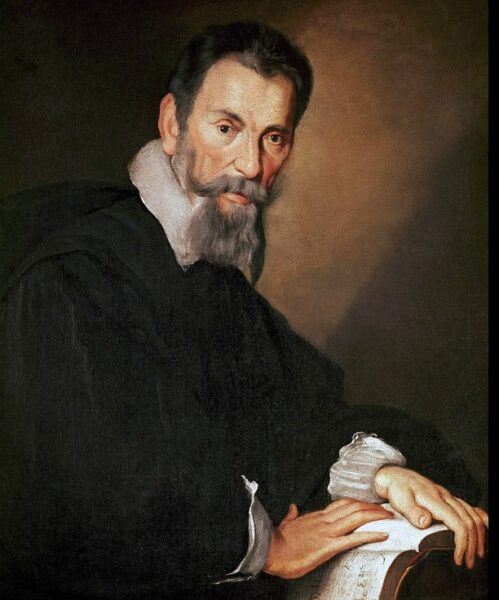Biography of Claudio Monteverdi
Claudio Giovanni Antonio Monteverdi (baptized 15 May 1567 – 29 November 1643) was an Italian composer and string player. More than anybody, he represents the transition from Renaissance music to Baroque, and was the forerunner in developing the opera as a new genre.
Monteverdi was born in Cremona, in 1567. His father was a barber-surgeon and a chemist, and there is no evidence young Monteverdi did learn any music at home, but rather with the music director of the local cathedral, Marcantonio Ingegneri.
At the age of 15 he made his first publication, his motets called Sacred Songs. Next year he released his first madrigals, Spiritual Madrigals, and later his secular compositions.
Around 1590 he joined the court of Gonzaga (Duke Vincenzo I Gonzaga) in Mantua. Initially, he was a string player in the orchestra, working under the direction of the maestro di capella Giaches de Wert and later Benedetto Pallavicino. He was highly regarded by the duke and after the death of Pallavicino, at the age of 35 was appointed as the new director of music. It was here, where he met his future wife, the court singer Claudia de Cattaneis. They had three children together.
As he went on publishing more books of his madrigals, he became the target of conservatives. His new approach to existing musical styles made him the figurehead of the contemporary avant-garde. In a series of pamphlets, Bolognese theorist Giovanni Maria Artusi was his most noisy critic. Monteverdi had promised a defense in writing (Seconda Pratica, overo Perfettione della Moderna Musica; The Second Style, or Perfection of Modern Music), something that he delayed so long, it became pointless, as Artusi later fully reconciled with the modern trends.
His next musical breakthrough came with a new opera commissioned for the 1607 carnival season by the heir of Duke Vincenzo, Francesco. The famous opera was the L’Orfeo, libretto by Alessandro Striggio. Although it was not his first opera, it was the one that first made broad acceptance. Based on the Orpheus myth, it contained various styles like recitatives, chorus, aria and instrumental interludes.
His next opera, Arianna (1608), proved to be even more popular. Fuelled by the recent death of his wife, the Lament portion (the first great operatic scena), made the biggest impact on the audiences.
|Related: A short history of Italian and German opera
Following the death of his wife, unstable and unhappy period knocked on his door. He had been in financial difficulties for some time, many times tried to cut ties with the Gonzaga-court, seeking employment elsewhere. He dedicated his next work Vespers to the Pope, visited both Rome and Venice, hoping for employment. Finally, he was appointed as director of music at the basilica of San Marco in Venice, in August 1613. His period in Venice revitalized Monteverdi. Not only was he well paid and honored, he had the freedom to accept commissions from other places. In 1637 Venice opened the first public opera house in Europe, the Teatro San Cassiano, making the city a leading cultural center.
In 1630 tragedies followed Monteverdi still. Habsburg armies occupied Mantua, looting treasures and dispersing the artistic community. The Italian-plague was carried over to Venice, which decimated the population to the lowest number in 150 years.
At this time Monteverdi was already an old man and the tragedies turned him more and more to religion. In 1631 he was appointed as a catholic priest in the Diocese of Cremona (indicating his plans to retire there, not in Venice). Despite his plans, he died in Venice on 29 November 1643, and was buried in Venice at the Church of the Frari.
His works in madrigals, sacred music and operas, his experiments with the second prattica styles make him the most influential composer of his time.

